Dennis Tewa
(1945-2013)
Award-winning Hopi Katsina Carver, Dennis Tewa, who passed on in 2013, was highly regarded for capturing motion in his work by collectors and other carvers.
And in “Blue Ahote” he didn’t disappoint. The “Ahote” originated from the Plains Indians, but was adopted into the Hopi culture. Typically, he comes in either yellow or blue and is presumed to be a good hunter. His long and trailing eagle feather headdress resembles those of Plains Indian. The “Ahote” appears in the Mixed Dance and the Plaza Dance during Hopi Ceremonies.
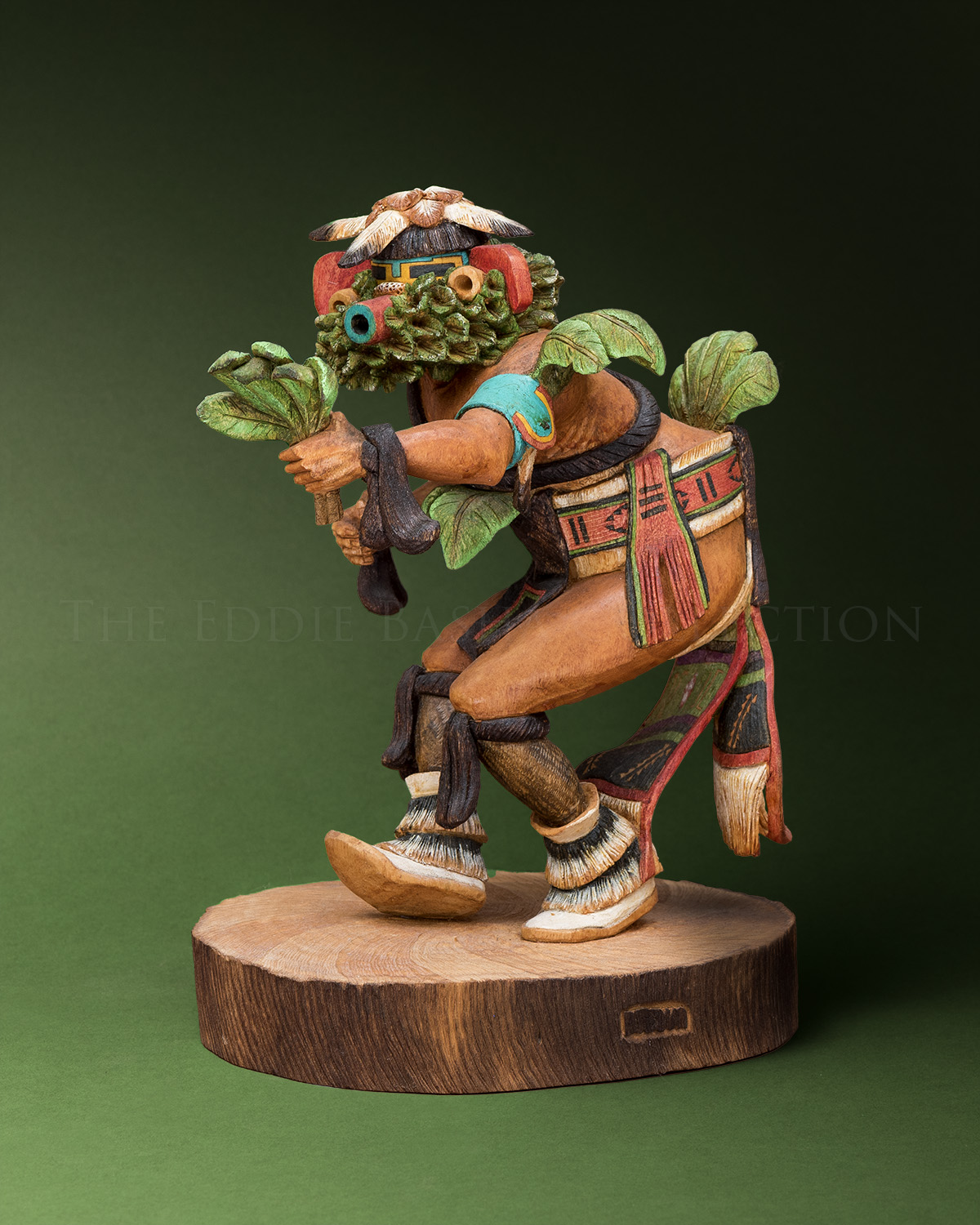
Yellow Corn Dancer (Qa’ ökatsina)
Artist: Dennis Tewa (1945-2013)
Description: Cottonwood Tree Root (1992) | Dimensions: 12”h x 9”w x 7”dkatsina
Corn, along with beans and squash, have been dietary staples of tribal communities residing in high desert, arid landscapes for thousands of years since they can be cultivated in unirrigated regions. Consequently, in every Hopi ceremony corn virtually appears in homage to the sustenance it has provided. It might show in its whole ear form, as corn meal, or represented in katsina or another art form.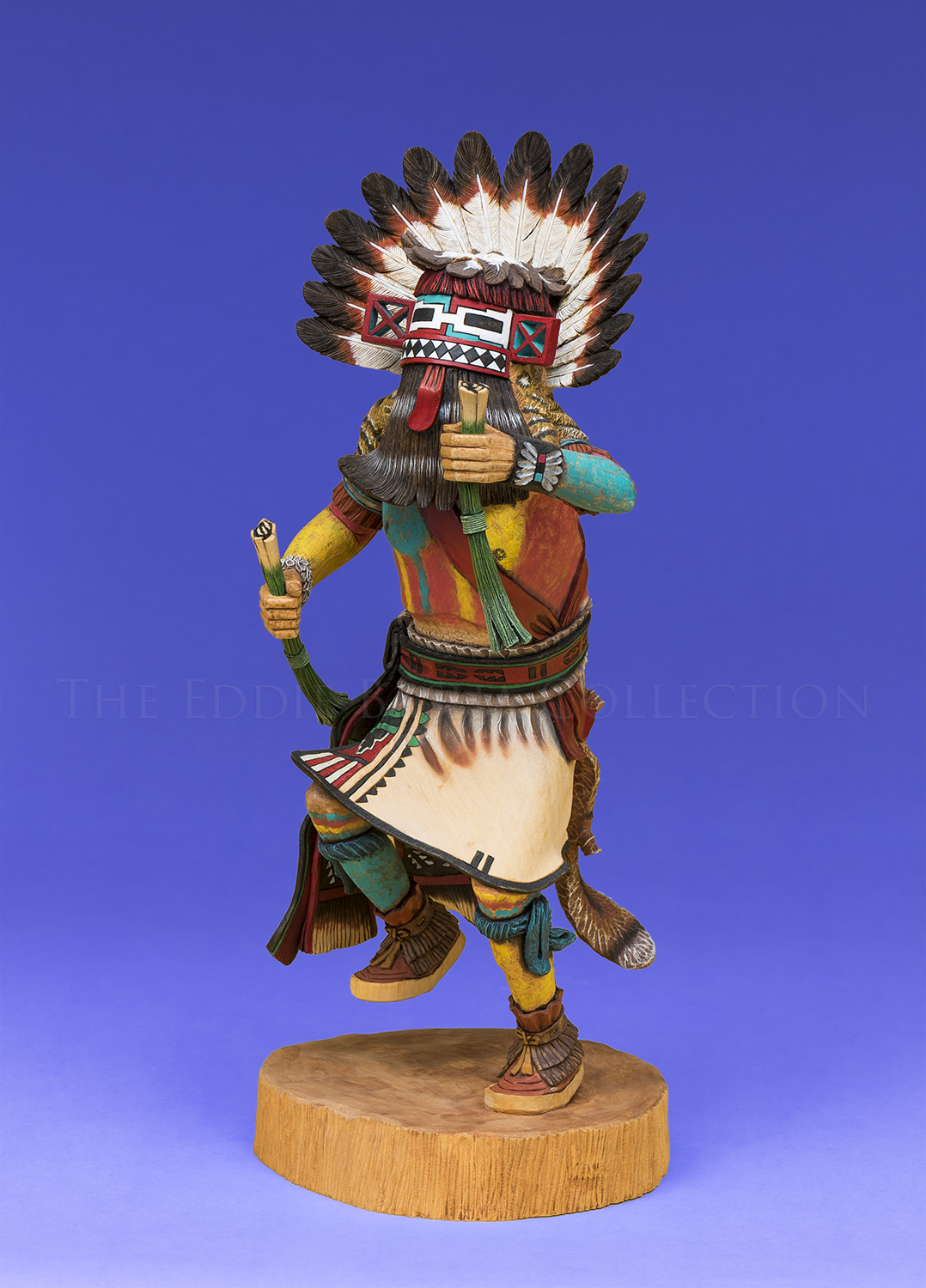
Hee’ Li li
Artist: Dennis Tewa (1945-2013)
Description: Cottonwood Tree Root | Dimensions: 19 ½”h x 8”w x 6”d”katsina
The name, Hee’ Li li or Hilili, was attributed to this katsina because of the sounds he makes during the Bean Planting Ceremony and at the Night Dances; an onomatopoeia. He is considered a guard and is admired for his rapid dancing.
Hee’ Li li was exhibited and purchased from Dennis Tewa at the 85th Annual Santa Fe Indian Market in August 2006.
Warrior Lady
Artist: Dennis Tewa (1945-2013)
Description: Cottonwood Tree Root | Dimensions: 15”h x 8”w x 7”dkatsina
In Helga Teiwes book, “Kachina Dolls: The Art of Hopi Carvers” she wrote the following about Hopi Carver Dennis Tewa: “Dennis is a master at creating folds and wrinkles in capes and other clothing that look agitated by the wind. Hems curl up and capes seem to billow in a gust sweeping through the plaza while the Katsinam dance. Collectors regard these motions in his carvings as his hallmark.” This apt description can readily be applied to Tewa’s “Warrior Maiden” shown here.
Eddie Basha frequented both venues annually, the Heard Museum Guild Indian Market and the Santa Fe Indian Market, where he would often be “first in line” to purchase the master carvers award winning pieces. After a long day behind their market booths, the artisans would often visit with Eddie at his home and enjoy comfort, camaraderie and refreshments.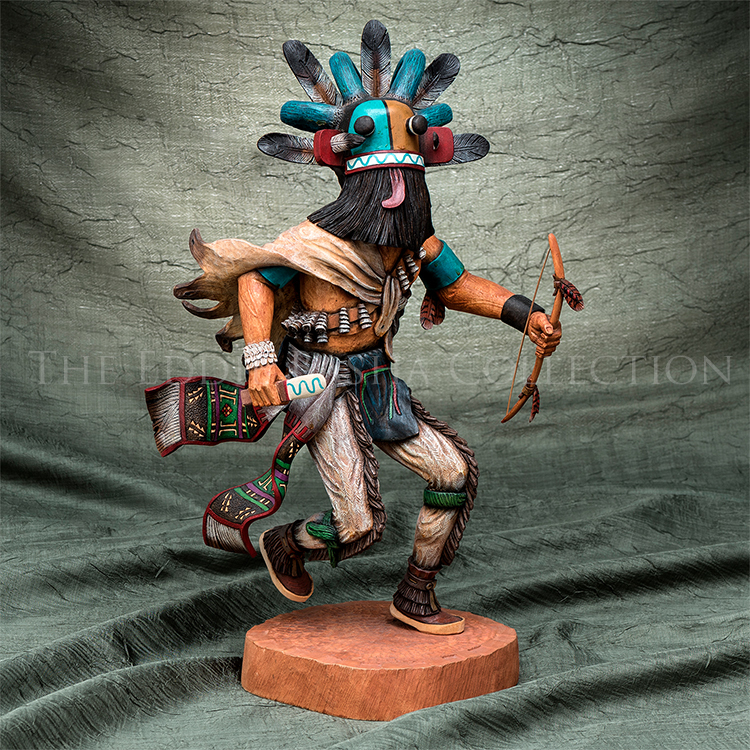
Pohaha (or Pohana)
Artist: Dennis Tewa (1945-2013)
Description: Katsina (Cottonwood Root) | Dimensions: 18”h x 9”w x 7”dkatsina
Though their religion can be very complex, the Hopi belief system has many gods and spirits often physically represented as katsina. As the caretakers of the Earth, they perform ceremonies to keep balance in the world and to satisfy the gods. Katsina have the power to bring rain, to assist and support, or reprimand, the activities and actions of villagers, and are the envoys between the spiritual domain and mortals.
Hopi also believe that the universe has gone through three phases, or worlds, and are presently in the fourth world. The Hopi believe that their long lost white brother, Pohaha (or Pohana), the four-horned katsina, will return. He went east at the onset of entering the Fourth World long, long ago. Upon his return, evil and wicked will be destroyed and peace will prevail. It is also said that when he returns, he will be wearing red and will bring with him the missing portion of a sacred stone which the Fire Clan possesses. It is also believed that Pohaha will come from the east, hence the reason that Hopi are typically buried facing east in anticipation of his arrival.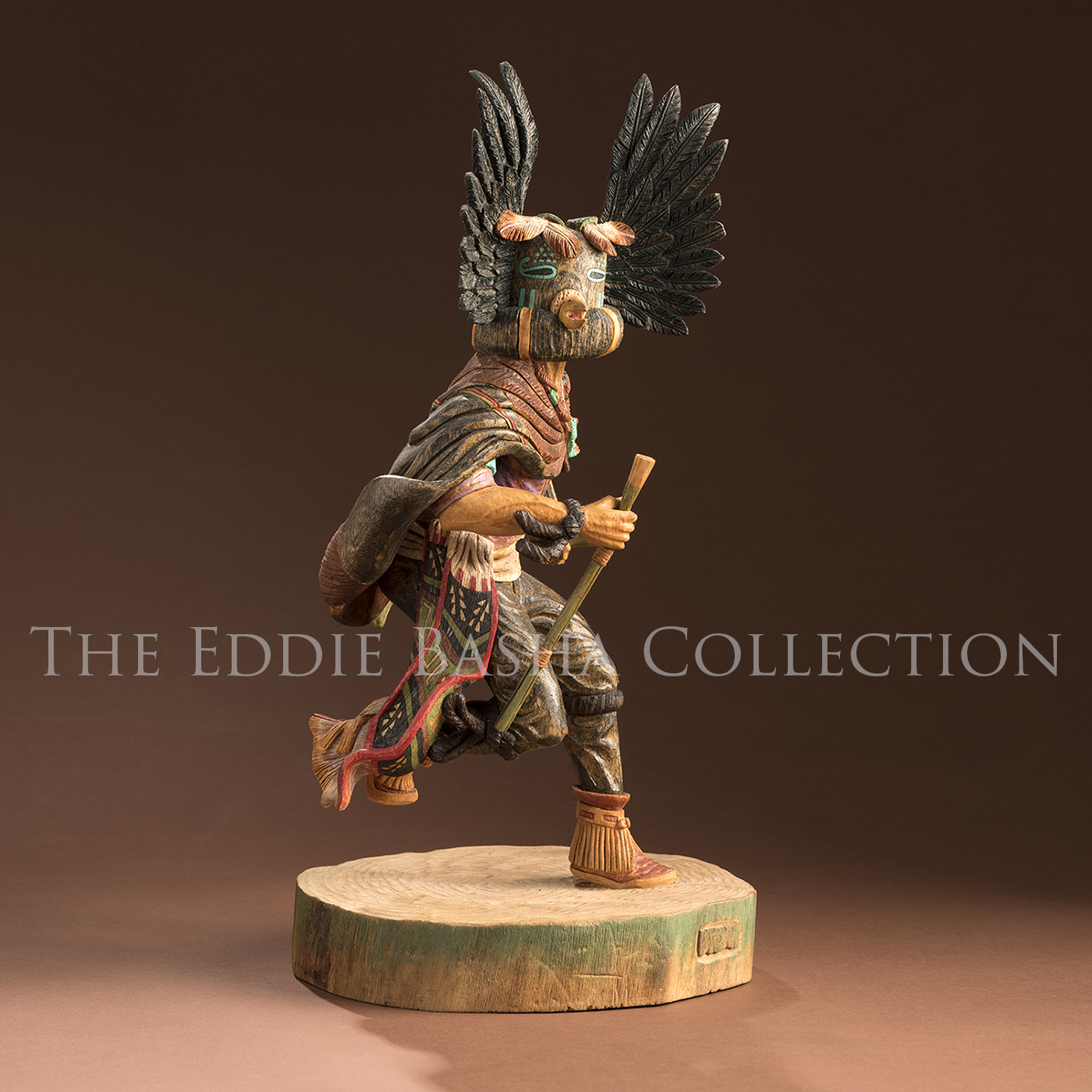
Crow Man
Artist: Dennis Tewa (1945-2013)
Description: Katsina (2002) | Dimensions: 15”h x 8”w x 7”dkatsina
The Crow or “Angwus” katsina typically appear during the Hopi Soyohim dances held in the spring and early summer calling for rain. The Angwus’ purpose, however, is to keep the clown katsina in check.
This Dennis Tewa carving is typical of his work and shows great detail, anatomical precision, motion, and action. Tewa was recognized by collectors and scholars as one of the best katsina doll carvers. He was taught by his cousin, Cecil Calnimptewa (also one of the best modern carvers), and like Calnimptewa, he specialized in one piece carvings fashioned from a single cottonwood tree root. Tewa received numerous awards at such acclaimed art venues as Indian Markets in both Santa Fe and Phoenix and the Museum of Northern Arizona in Flagstaff.
The Cow
Artist: Dennis Tewa (1945-2013)
Description: Cottonwood Root Katsina (1998) | 19”h x 8”w x 6”dkatsina
Blue Ahote Katsina
Artist: Dennis Tewa (1945-2013)
Description: Cottonwood Tree Root | 18”hkatsina
Award-winning Hopi Katsina Carver Dennis Tewa who passed on in 2013 was highly regarded for capturing motion in his work by collectors and amongst other carvers. And in “Blue Ahote” he didn’t disappoint.
The “Ahote” originated from the Plains Indians, but was adopted into the Hopi culture. Typically, he comes in either yellow or blue and is presumed to be a good hunter. His long and trailing eagle feather headdress resembles those of Plains Indian. The “Ahote” appears in the Mixed Dance and the Plaza Dance during Hopi Ceremonies.
 Cottonwood Tree Root (1992) | Dimensions: 12”h x 9”w x 7”d
Cottonwood Tree Root (1992) | Dimensions: 12”h x 9”w x 7”dCorn, along with beans and squash, have been dietary staples of tribal communities residing in high desert, arid landscapes for thousands of years since they can be cultivated in unirrigated regions. Consequently, in every Hopi ceremony corn virtually appears in homage to the sustenance it has provided. It might show in its whole ear form, as corn meal, or represented in katsina or another art form.
Yellow Corn Dancer (Qa’ ökatsina)
Artist: Dennis Tewa (1945-2013)
Description:
Cottonwood Tree Root (1992) | Dimensions: 12”h x 9”w x 7”d
Corn, along with beans and squash, have been dietary staples of tribal communities residing in high desert, arid landscapes for thousands of years since they can be cultivated in unirrigated regions. Consequently, in every Hopi ceremony corn virtually appears in homage to the sustenance it has provided. It might show in its whole ear form, as corn meal, or represented in katsina or another art form.
katsinaCorn, along with beans and squash, have been dietary staples of tribal communities residing in high desert, arid landscapes for thousands of years since they can be cultivated in unirrigated regions. Consequently, in every Hopi ceremony corn virtually appears in homage to the sustenance it has provided. It might show in its whole ear form, as corn meal, or represented in katsina or another art form.
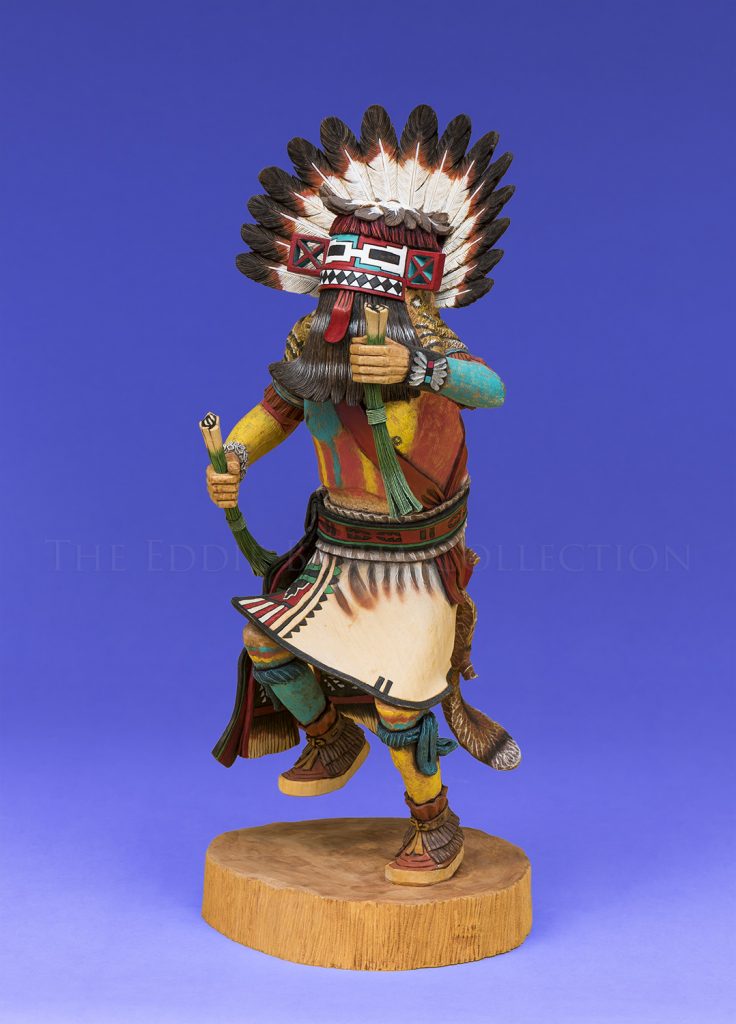 Cottonwood Tree Root | Dimensions: 19 ½”h x 8”w x 6”d”
Cottonwood Tree Root | Dimensions: 19 ½”h x 8”w x 6”d”The name, Hee’ Li li or Hilili, was attributed to this katsina because of the sounds he makes during the Bean Planting Ceremony and at the Night Dances; an onomatopoeia. He is considered a guard and is admired for his rapid dancing.
Hee’ Li li was exhibited and purchased from Dennis Tewa at the 85th Annual Santa Fe Indian Market in August 2006.
Hee’ Li li
Artist: Dennis Tewa (1945-2013)
Description:
Cottonwood Tree Root | Dimensions: 19 ½”h x 8”w x 6”d”
The name, Hee’ Li li or Hilili, was attributed to this katsina because of the sounds he makes during the Bean Planting Ceremony and at the Night Dances; an onomatopoeia. He is considered a guard and is admired for his rapid dancing.
Hee’ Li li was exhibited and purchased from Dennis Tewa at the 85th Annual Santa Fe Indian Market in August 2006.
katsinaThe name, Hee’ Li li or Hilili, was attributed to this katsina because of the sounds he makes during the Bean Planting Ceremony and at the Night Dances; an onomatopoeia. He is considered a guard and is admired for his rapid dancing.
Hee’ Li li was exhibited and purchased from Dennis Tewa at the 85th Annual Santa Fe Indian Market in August 2006.
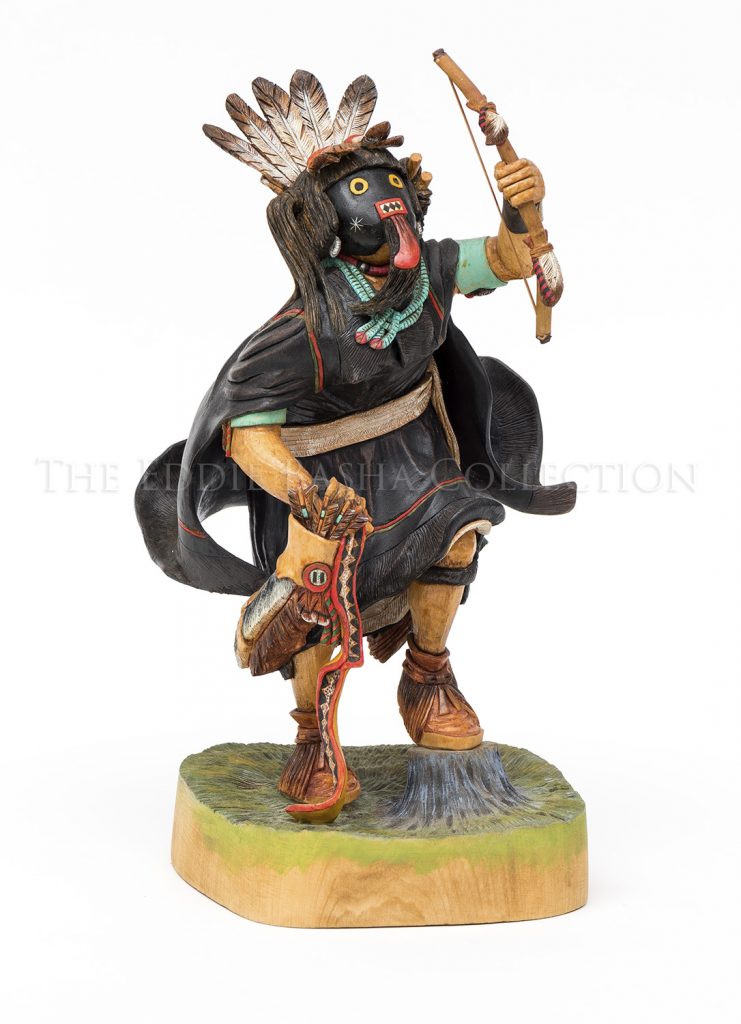 Cottonwood Tree Root | Dimensions: 15”h x 8”w x 7”d
Cottonwood Tree Root | Dimensions: 15”h x 8”w x 7”dIn Helga Teiwes book, “Kachina Dolls: The Art of Hopi Carvers” she wrote the following about Hopi Carver Dennis Tewa: “Dennis is a master at creating folds and wrinkles in capes and other clothing that look agitated by the wind. Hems curl up and capes seem to billow in a gust sweeping through the plaza while the Katsinam dance. Collectors regard these motions in his carvings as his hallmark.” This apt description can readily be applied to Tewa’s “Warrior Maiden” shown here.
Eddie Basha frequented both venues annually, the Heard Museum Guild Indian Market and the Santa Fe Indian Market, where he would often be “first in line” to purchase the master carvers award winning pieces. After a long day behind their market booths, the artisans would often visit with Eddie at his home and enjoy comfort, camaraderie and refreshments.
Warrior Lady
Artist: Dennis Tewa (1945-2013)
Description:
Cottonwood Tree Root | Dimensions: 15”h x 8”w x 7”d
In Helga Teiwes book, “Kachina Dolls: The Art of Hopi Carvers” she wrote the following about Hopi Carver Dennis Tewa: “Dennis is a master at creating folds and wrinkles in capes and other clothing that look agitated by the wind. Hems curl up and capes seem to billow in a gust sweeping through the plaza while the Katsinam dance. Collectors regard these motions in his carvings as his hallmark.” This apt description can readily be applied to Tewa’s “Warrior Maiden” shown here.
Eddie Basha frequented both venues annually, the Heard Museum Guild Indian Market and the Santa Fe Indian Market, where he would often be “first in line” to purchase the master carvers award winning pieces. After a long day behind their market booths, the artisans would often visit with Eddie at his home and enjoy comfort, camaraderie and refreshments.
katsinaIn Helga Teiwes book, “Kachina Dolls: The Art of Hopi Carvers” she wrote the following about Hopi Carver Dennis Tewa: “Dennis is a master at creating folds and wrinkles in capes and other clothing that look agitated by the wind. Hems curl up and capes seem to billow in a gust sweeping through the plaza while the Katsinam dance. Collectors regard these motions in his carvings as his hallmark.” This apt description can readily be applied to Tewa’s “Warrior Maiden” shown here.
Eddie Basha frequented both venues annually, the Heard Museum Guild Indian Market and the Santa Fe Indian Market, where he would often be “first in line” to purchase the master carvers award winning pieces. After a long day behind their market booths, the artisans would often visit with Eddie at his home and enjoy comfort, camaraderie and refreshments.
 Katsina (Cottonwood Root) | Dimensions: 18”h x 9”w x 7”d
Katsina (Cottonwood Root) | Dimensions: 18”h x 9”w x 7”dThough their religion can be very complex, the Hopi belief system has many gods and spirits often physically represented as katsina. As the caretakers of the Earth, they perform ceremonies to keep balance in the world and to satisfy the gods. Katsina have the power to bring rain, to assist and support, or reprimand, the activities and actions of villagers, and are the envoys between the spiritual domain and mortals.
Hopi also believe that the universe has gone through three phases, or worlds, and are presently in the fourth world. The Hopi believe that their long lost white brother, Pohaha (or Pohana), the four-horned katsina, will return. He went east at the onset of entering the Fourth World long, long ago. Upon his return, evil and wicked will be destroyed and peace will prevail. It is also said that when he returns, he will be wearing red and will bring with him the missing portion of a sacred stone which the Fire Clan possesses. It is also believed that Pohaha will come from the east, hence the reason that Hopi are typically buried facing east in anticipation of his arrival.
Pohaha (or Pohana)
Artist: Dennis Tewa (1945-2013)
Description:
Katsina (Cottonwood Root) | Dimensions: 18”h x 9”w x 7”d
Though their religion can be very complex, the Hopi belief system has many gods and spirits often physically represented as katsina. As the caretakers of the Earth, they perform ceremonies to keep balance in the world and to satisfy the gods. Katsina have the power to bring rain, to assist and support, or reprimand, the activities and actions of villagers, and are the envoys between the spiritual domain and mortals.
Hopi also believe that the universe has gone through three phases, or worlds, and are presently in the fourth world. The Hopi believe that their long lost white brother, Pohaha (or Pohana), the four-horned katsina, will return. He went east at the onset of entering the Fourth World long, long ago. Upon his return, evil and wicked will be destroyed and peace will prevail. It is also said that when he returns, he will be wearing red and will bring with him the missing portion of a sacred stone which the Fire Clan possesses. It is also believed that Pohaha will come from the east, hence the reason that Hopi are typically buried facing east in anticipation of his arrival.
katsinaThough their religion can be very complex, the Hopi belief system has many gods and spirits often physically represented as katsina. As the caretakers of the Earth, they perform ceremonies to keep balance in the world and to satisfy the gods. Katsina have the power to bring rain, to assist and support, or reprimand, the activities and actions of villagers, and are the envoys between the spiritual domain and mortals.
Hopi also believe that the universe has gone through three phases, or worlds, and are presently in the fourth world. The Hopi believe that their long lost white brother, Pohaha (or Pohana), the four-horned katsina, will return. He went east at the onset of entering the Fourth World long, long ago. Upon his return, evil and wicked will be destroyed and peace will prevail. It is also said that when he returns, he will be wearing red and will bring with him the missing portion of a sacred stone which the Fire Clan possesses. It is also believed that Pohaha will come from the east, hence the reason that Hopi are typically buried facing east in anticipation of his arrival.
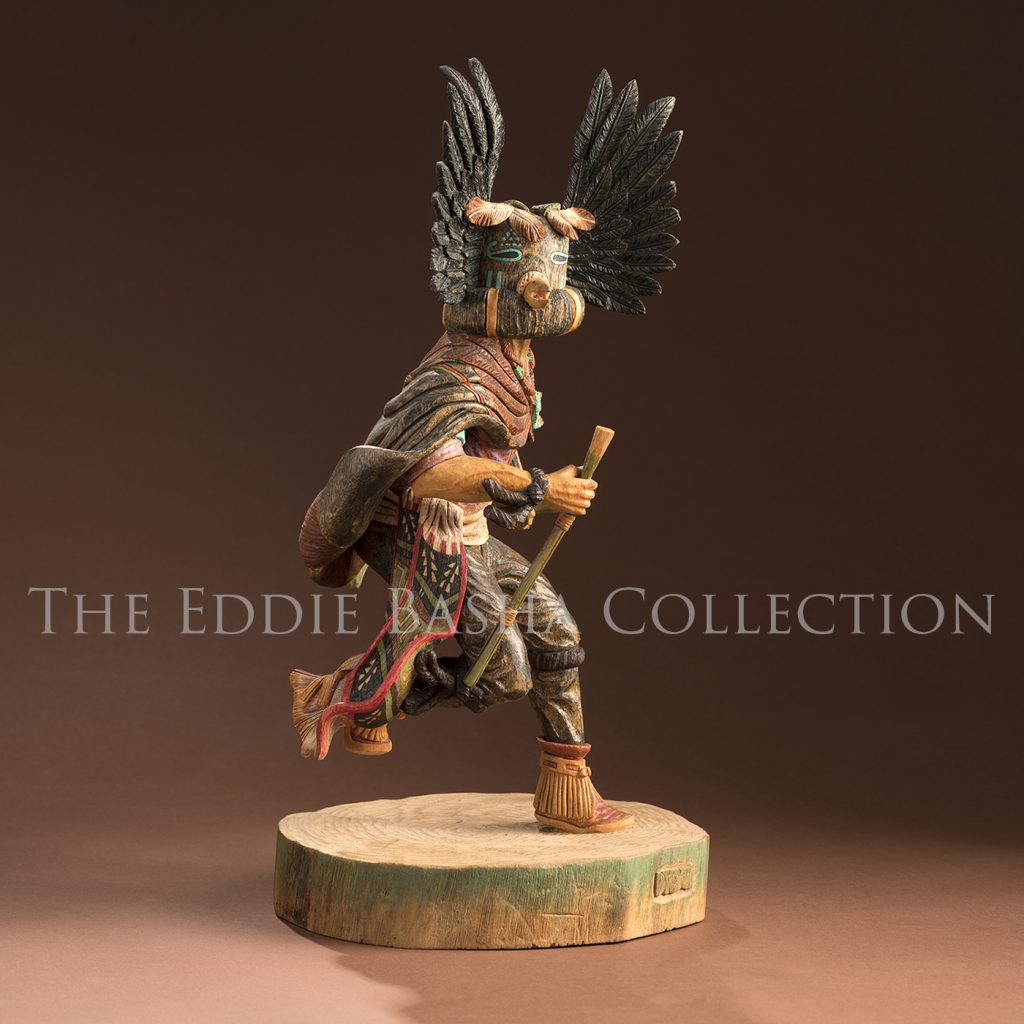 Katsina (2002) | Dimensions: 15”h x 8”w x 7”d
Katsina (2002) | Dimensions: 15”h x 8”w x 7”dThe Crow or “Angwus” katsina typically appear during the Hopi Soyohim dances held in the spring and early summer calling for rain. The Angwus’ purpose, however, is to keep the clown katsina in check.
This Dennis Tewa carving is typical of his work and shows great detail, anatomical precision, motion, and action. Tewa was recognized by collectors and scholars as one of the best katsina doll carvers. He was taught by his cousin, Cecil Calnimptewa (also one of the best modern carvers), and like Calnimptewa, he specialized in one piece carvings fashioned from a single cottonwood tree root. Tewa received numerous awards at such acclaimed art venues as Indian Markets in both Santa Fe and Phoenix and the Museum of Northern Arizona in Flagstaff.
Crow Man
Artist: Dennis Tewa (1945-2013)
Description:
Katsina (2002) | Dimensions: 15”h x 8”w x 7”d
The Crow or “Angwus” katsina typically appear during the Hopi Soyohim dances held in the spring and early summer calling for rain. The Angwus’ purpose, however, is to keep the clown katsina in check.
This Dennis Tewa carving is typical of his work and shows great detail, anatomical precision, motion, and action. Tewa was recognized by collectors and scholars as one of the best katsina doll carvers. He was taught by his cousin, Cecil Calnimptewa (also one of the best modern carvers), and like Calnimptewa, he specialized in one piece carvings fashioned from a single cottonwood tree root. Tewa received numerous awards at such acclaimed art venues as Indian Markets in both Santa Fe and Phoenix and the Museum of Northern Arizona in Flagstaff.
katsinaThe Crow or “Angwus” katsina typically appear during the Hopi Soyohim dances held in the spring and early summer calling for rain. The Angwus’ purpose, however, is to keep the clown katsina in check.
This Dennis Tewa carving is typical of his work and shows great detail, anatomical precision, motion, and action. Tewa was recognized by collectors and scholars as one of the best katsina doll carvers. He was taught by his cousin, Cecil Calnimptewa (also one of the best modern carvers), and like Calnimptewa, he specialized in one piece carvings fashioned from a single cottonwood tree root. Tewa received numerous awards at such acclaimed art venues as Indian Markets in both Santa Fe and Phoenix and the Museum of Northern Arizona in Flagstaff.
 Cottonwood Root Katsina (1998) | 19”h x 8”w x 6”d
Cottonwood Root Katsina (1998) | 19”h x 8”w x 6”dThe Cow
Artist: Dennis Tewa (1945-2013)
Description:
Cottonwood Root Katsina (1998) | 19”h x 8”w x 6”d
katsina Cottonwood Tree Root | 18”h
Cottonwood Tree Root | 18”h Award-winning Hopi Katsina Carver Dennis Tewa who passed on in 2013 was highly regarded for capturing motion in his work by collectors and amongst other carvers. And in “Blue Ahote” he didn’t disappoint.
The “Ahote” originated from the Plains Indians, but was adopted into the Hopi culture. Typically, he comes in either yellow or blue and is presumed to be a good hunter. His long and trailing eagle feather headdress resembles those of Plains Indian. The “Ahote” appears in the Mixed Dance and the Plaza Dance during Hopi Ceremonies.
Blue Ahote Katsina
Artist: Dennis Tewa (1945-2013)
Description:
Cottonwood Tree Root | 18”h
Award-winning Hopi Katsina Carver Dennis Tewa who passed on in 2013 was highly regarded for capturing motion in his work by collectors and amongst other carvers. And in “Blue Ahote” he didn’t disappoint.
The “Ahote” originated from the Plains Indians, but was adopted into the Hopi culture. Typically, he comes in either yellow or blue and is presumed to be a good hunter. His long and trailing eagle feather headdress resembles those of Plains Indian. The “Ahote” appears in the Mixed Dance and the Plaza Dance during Hopi Ceremonies.
katsinaAward-winning Hopi Katsina Carver Dennis Tewa who passed on in 2013 was highly regarded for capturing motion in his work by collectors and amongst other carvers. And in “Blue Ahote” he didn’t disappoint.
The “Ahote” originated from the Plains Indians, but was adopted into the Hopi culture. Typically, he comes in either yellow or blue and is presumed to be a good hunter. His long and trailing eagle feather headdress resembles those of Plains Indian. The “Ahote” appears in the Mixed Dance and the Plaza Dance during Hopi Ceremonies.